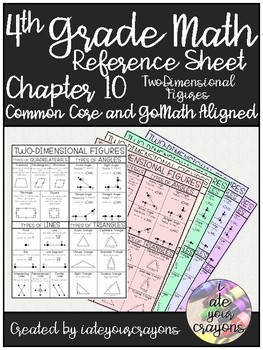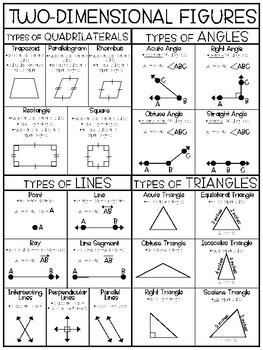4th Grade Math Reference Sheet (Go-Math Chapter 10)
iAteYourCrayons
57 Followers
Grade Levels
3rd - 5th
Subjects
Resource Type
Standards
CCSS4.MD.C.5
CCSS3.G.A.1
CCSS4.G.A.1
CCSS4.G.A.2
CCSS5.G.A.1
Formats Included
- PDF
Pages
1 page
iAteYourCrayons
57 Followers
What educators are saying
This was a great resource for the students to use as the worked on assignments and studied for their test.
This is a great resource. It kept my students engaged and helped them learn what they needed to know.
Description
This math reference sheet is exactly what you need to help support your students in learning quadrilaterals, lines, angles, and triangles. Use as a preview for third graders, for instruction in fourth grade, or as a review sheet for fifth grade. Aligned to fourth grade standards and to Go-Math Chapter 10.
With no added colors or distracting designs, this sheet is printer-friendly and easily accessible for your diverse range of students.
In this math reference sheet, you will find:
Types of Quadrilaterals
-Trapezoid
-Parallelogram
-Rhombus
-Rectangle
-Square
Types of Lines
-Line
-Line Segment
-Ray
-Point
Types of Angles
-Right Angle
-Acute Angle
-Obtuse Angle
-Straight Angle
Types of Triangles
-Acute Triangle
-Obtuse Triangle
-Right Triangle
-Equilateral Triangle
-Isosceles Triangle
-Scalene Triangle
This product can be also be found in the '4th Grade Math Reference Sheet Bundle' found in my store. Purchase this bundle at a discounted price and receive reference sheets for:
-Each 4th-grade math topic, broken down into thirteen sections and aligned to chapters 1 through 13 of Go-Math curriculum (but accessible for all)
-Multi-digit addition
-Multi-digit subtraction
-Multi-digit multiplication
-Long division
Interested in more reference sheets? Send me a message with your request!
With no added colors or distracting designs, this sheet is printer-friendly and easily accessible for your diverse range of students.
In this math reference sheet, you will find:
Types of Quadrilaterals
-Trapezoid
-Parallelogram
-Rhombus
-Rectangle
-Square
Types of Lines
-Line
-Line Segment
-Ray
-Point
Types of Angles
-Right Angle
-Acute Angle
-Obtuse Angle
-Straight Angle
Types of Triangles
-Acute Triangle
-Obtuse Triangle
-Right Triangle
-Equilateral Triangle
-Isosceles Triangle
-Scalene Triangle
This product can be also be found in the '4th Grade Math Reference Sheet Bundle' found in my store. Purchase this bundle at a discounted price and receive reference sheets for:
-Each 4th-grade math topic, broken down into thirteen sections and aligned to chapters 1 through 13 of Go-Math curriculum (but accessible for all)
-Multi-digit addition
-Multi-digit subtraction
-Multi-digit multiplication
-Long division
Interested in more reference sheets? Send me a message with your request!
Total Pages
1 page
Answer Key
N/A
Teaching Duration
N/A
Report this resource to TPT
Reported resources will be reviewed by our team. Report this resource to let us know if this resource violates TPT’s content guidelines.
Standards
to see state-specific standards (only available in the US).
CCSS4.MD.C.5
Recognize angles as geometric shapes that are formed wherever two rays share a common endpoint, and understand concepts of angle measurement:
CCSS3.G.A.1
Understand that shapes in different categories (e.g., rhombuses, rectangles, and others) may share attributes (e.g., having four sides), and that the shared attributes can define a larger category (e.g., quadrilaterals). Recognize rhombuses, rectangles, and squares as examples of quadrilaterals, and draw examples of quadrilaterals that do not belong to any of these subcategories.
CCSS4.G.A.1
Draw points, lines, line segments, rays, angles (right, acute, obtuse), and perpendicular and parallel lines. Identify these in two-dimensional figures.
CCSS4.G.A.2
Classify two-dimensional figures based on the presence or absence of parallel or perpendicular lines, or the presence or absence of angles of a specified size. Recognize right triangles as a category, and identify right triangles.
CCSS5.G.A.1
Use a pair of perpendicular number lines, called axes, to define a coordinate system, with the intersection of the lines (the origin) arranged to coincide with the 0 on each line and a given point in the plane located by using an ordered pair of numbers, called its coordinates. Understand that the first number indicates how far to travel from the origin in the direction of one axis, and the second number indicates how far to travel in the direction of the second axis, with the convention that the names of the two axes and the coordinates correspond (e.g., 𝘹-axis and 𝘹-coordinate, 𝘺-axis and 𝘺-coordinate).



